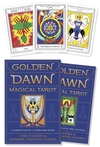In the Beginning: The Creation of the Babylonian Tarot

It was back in the summer of 1984 as we were driving though the streets of Savannah, Georgia, when out of the blue, Chic turned to me and said, "You know, you are more Ishtar than Isis." This got my attention and started me thinking. He was right.
Although my magical interests at that time centered on the powerful gods and goddesses of ancient Egypt—the wise Thoth, the immortal Osiris, the great lady Isis—I had always been fascinated by the legends of Mesopotamia (which is Greek for "the land between the rivers"). It was then that I realized that since childhood I clearly remembered dreaming of the votive statues found in ancient Sumerian temples, their hands clasped in devotional poses and their huge eyes opened wide with awe in the presence of their patron deity. It was evident that a connection existed for me there, and I just had to follow it and see where it led.
I knew that Ishtar was the most important goddess in the Babylonian pantheon. A complex goddess of many roles, Ishtar, whose Sumerian name of Inanna meant "lady of heaven," was the celestial goddess of Venus, the morning and evening star and the goddess of the dualities of love and war. She was predominantly a goddess of brilliance, light, and wisdom. This much I already knew, but I wanted to know more. So it was then that I began to study the legends of Mesopotamia, or Babylonia as it is often called. I incorporated the name of the goddess Ishtar into my own magical name, seeking to use her dual aspects of love and war as a symbolic gateway to a Middle Path of balance and equilibrium between these two opposing forces.
Even older than mighty Egypt, Mesopotamia was the original "cradle of civilization" located in the Fertile Crescent valley between the Tigris and Euphrates rivers—an area now occupied by modern-day Iraq and parts of Syria and Turkey. It was in Mesopotamia that the ancient Sumerians built the world's first cities and composed humanity's earliest writings. Their culture eventually outlasted them and became the basis for all later Babylonian civilization. The Sumerian way of life, style of writing and religious customs were preserved throughout ancient times by the kingdoms that followed—the Akkadian, Babylonian, and Assyrian empires. The Sumerian gods and goddesses were also adopted by successive civilizations in the region, and although the names of these deities were often altered, their basic characteristics, personalities, and symbolism changed little.
I was captivated by the many elements of Babylonian spiritual belief, religious practice, and cosmology that found their way into the Hebrew Scriptures in such legends as the Creation Story and the Great Flood. Many Biblical passages of the "Old Testament" can be traced directly to the more ancient beliefs of the Babylonians, the inheritors of the geographic remnants of Eden. The characteristics of the Hebrew god Yahweh were directly shaped by those of earlier Babylonian sky gods such as Ellil and Marduk, as well as their Canaanite cousin, Baal. Thus the Babylonians had an important influence on the Judeo-Christian traditions that form the foundation of the Western Esoteric Tradition.
The Babylonians were an agricultural people who worshiped the natural forces of the universe that ruled the skies and governed the fertility of the earth. It was considered the duty of every person to carry out the gods' will on earth, implementing a divine order that would secure the prosperity of the land and its people. There were cosmic gods, underworld gods, city gods, and gods of nature. It is these most ancient deities and spirits of "the Land between the Rivers" that are the subject of The Babylonian Tarot.
In the spring of 2002, I began work on the cards. As I immersed myself in the literature of ancient Mesopotamia and texts written by a wide array of Assyrian-Babylonian scholars from the nineteenth and twentieth centuries, I grew more and more fascinated with the Babylonian divinities and the men and women who worshiped them ages ago. Unlike the Egyptian gods and goddesses whose stories were preserved on papyrus, the narratives of the Babylonian deities were written on fragile clay tablets in an alien-looking form of writing known as cuneiform. Many of these old tablets have been lost, damaged or destroyed—often making it difficult for scholars to coax the secrets of the earliest-known gods out from the crumbling archives of history into the light of day. Applying these elusive deities to the framework of the tarot became an inspiring quest in its own right.
One of the ways I sought to pay homage to the sheer antiquity of the Babylonian mythos was to add an extra Trump card. Most tarot decks start with Key 0: The Fool, but I needed a card that could portray the very essence of the "Beginning"—as written in world's oldest recorded Creation Story. The result was the card of Genesis, which represents the birth of the universe—an event lost in the primordial mists of time.
The Babylonian Tarot is the outcome of my personal journey of exploration into ancient Mesopotamian culture, literature, and spiritual belief. It is a journey I am happy to be able to share.

About Sandra Tabatha Cicero
Related Products

is subject to certain Terms and Conditions